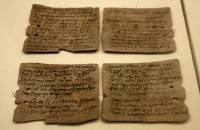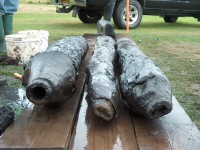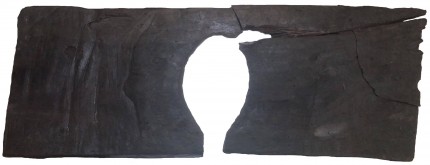 The Roman fort and settlement of Vindolanda just south of Hadrian’s Wall in Northumberland is perhaps best known for the 1,700 wooden writing tablets from the 1st and 2nd centuries A.D. that have been found there, preserved for 2,000 years in the site’s anaerobic soil. Because of the unique insight this record of daily correspondence gives us into the daily lives of the ancient Romans and Britons who lived at Vindolanda, the tablets were voted Britain’s top archaeological treasure by British Museum curators in 2003. They have been extensively studied and displayed at the Vindolanda Museum.
The Roman fort and settlement of Vindolanda just south of Hadrian’s Wall in Northumberland is perhaps best known for the 1,700 wooden writing tablets from the 1st and 2nd centuries A.D. that have been found there, preserved for 2,000 years in the site’s anaerobic soil. Because of the unique insight this record of daily correspondence gives us into the daily lives of the ancient Romans and Britons who lived at Vindolanda, the tablets were voted Britain’s top archaeological treasure by British Museum curators in 2003. They have been extensively studied and displayed at the Vindolanda Museum.
Less known are the many other wooden objects discovered at Vindolanda. Almost 1,500 artifacts have been unearthed from that blessedly waterlogged soil — cart axles, bread shovels, potter’s wheels, plank flooring, joists, that amazing inscribed barrel stave and my personal favorite, the only Roman wooden toilet seat ever discovered.
 They even found intact water pipes made of alder wood logs, bark still on them, that had been drilled through the length with an auger, creating a hollow center 5 centimeters (two inches) in diameter. There were 30 yards of pipes joined with oak junction boxes to create a network of water mains supplying Vindolanda with fresh water from a local spring. The ends of the logs were tapered to fit a hole in a block of oak. On the other side of the block another hole was drilled and another tapered log fitted into it. That was some quality joinery. With nary a single iron or lead fitting to keep the pipes together and almost two millennia after they were installed, the alder water pipes were still working when they were excavated in 2003, carrying fresh water to a building that archaeologists believe may have been a hospital. Lead pipes, even tile ones, are fairly common in the Roman world, but wood pipes are very rare — usually only the metal collars survive — and ones still in working order are rarer than hen’s teeth. As far as I was able to ascertain, the Vindolanda pipes are unique.
They even found intact water pipes made of alder wood logs, bark still on them, that had been drilled through the length with an auger, creating a hollow center 5 centimeters (two inches) in diameter. There were 30 yards of pipes joined with oak junction boxes to create a network of water mains supplying Vindolanda with fresh water from a local spring. The ends of the logs were tapered to fit a hole in a block of oak. On the other side of the block another hole was drilled and another tapered log fitted into it. That was some quality joinery. With nary a single iron or lead fitting to keep the pipes together and almost two millennia after they were installed, the alder water pipes were still working when they were excavated in 2003, carrying fresh water to a building that archaeologists believe may have been a hospital. Lead pipes, even tile ones, are fairly common in the Roman world, but wood pipes are very rare — usually only the metal collars survive — and ones still in working order are rarer than hen’s teeth. As far as I was able to ascertain, the Vindolanda pipes are unique.
As rare and historically significant as they are, none of these wooden treasures have been exhibited. Conserving, stabilizing and storing them once they have been removed from their protective environment is expensive, difficult work. Creating a display space with the technology to ensure the long-term preservation of the wooden objects while making them viewable to the public is a far greater challenge still.
 A Heritage Lottery Fund (HLF) grant has gotten the ball rolling. The Vindolanda Trust was able to secure a development grant of £20,400 ($25,400) from the HLF to develop the plans for a new addition to the site’s already excellent museum. The new space will be dedicated solely to the wooden artifacts that have been hidden away in storage for years.
A Heritage Lottery Fund (HLF) grant has gotten the ball rolling. The Vindolanda Trust was able to secure a development grant of £20,400 ($25,400) from the HLF to develop the plans for a new addition to the site’s already excellent museum. The new space will be dedicated solely to the wooden artifacts that have been hidden away in storage for years.
The popular museum will be expanded to create a new gallery with special display cases allowing temperature and humidity to be kept at safe levels. Not only will this mean their story can finally be told but it will also ensure they survive for future generations to enjoy.
Visitors will also hear the incredible survival story of the collection – from the science behind how they lasted two millennia, to their conservation and the research that is uncovering their origins.
Now, obviously the new gallery will cost vast sums more than the initial grant. This is just the first step. The Vindolanda Trust must have a fully developed and budgeted plan for the new gallery before the HLF can consider a much larger grant for the actual construction phase. Once the plans are complete, the Trust will apply for the full grant of £1,339,000 ($1,670,000). Then we can gaze in awe at the toilet seat and give it its proper respect. Some might be tempted to take a bunch of selfies squatting in front of the display case, but we’re all too dignified for those sorts of shenanigans, am I right?

I say the find of them still working with water flowing through them, is absolutely amazing. Why take them apart? Viewing, or even just knowing that the pipes are functioning as they should after two thousand years, seems more precious and valuable than putting them in museums.
I don’t have personal knowledge as to what went into the decision-making process, but generally speaking, when an organic material is unearthed, it immediately starts to decay. From perfectly preserved to falling apart can be a very rapid process. Displaying it in situ would not prevent this, since at least some of the pipe system would have to be exposed in order for there to be anything to see. So the choices would have been to rebury the pipes, which could exacerbate pre-existing water pooling issues (the archaeologists excavating the pipes were hip deep in a very mucky puddle) and hamper excavations in that area of the site, or remove them and conserve them.
Wow. We found a 2000 water main, still supplying water.. Let’s break it!
“Beam it down, Scotty !”
The Roman sewers under York are still in working nick, according to a Beeb programme I saw perhaps twenty years ago. I suppose anything Roman buried deep enough to avoid frost and Vikings must have a chance of still being in good order.
The Cloaca Maxima is still doing its thing, and some parts of that sewer predate the Roman Republic, nevermind the Roman Empire. It needs a lot of maintenance, though, more than it gets.
Keene, NH, a few years back, excavated water mains under the main street and discovered bored oak trunks with the bark on them, used as pipes still functioning after 250 years.
That is so cool.
Fascinating stuff indeed and what impressed me the most about the wooden toilet seat was how that design for the opening is still being used many hundreds of years later in many different countries. The beautiful simplicity of functionality ensures it’s survival as long as the need for it continues. And let’s face it, all these years later “Shit still happens. 😉
Very true. A manufacturer of high-end wooden toilet seats created a special edition inspired by the Vindolanda find with part of the proceeds going to the museum. Some things never go out of style.
Roman dams still work, their aqueducts still work, let’s face it–Romans didn’t mess around. They expected their stuff to work because they didn’t want to have to build it a second time.
My wife and I thought Vindolanda was a fascinating place when we visited in summer ’87…now obviously it is even more so – pray we’ll be able to return before we become archaeological exhibits. Tempus fugit!
😉
Even if it’s an extremely cool one (found at a rather cool place) – At the end of the day, what we are here talking about, is a toilet almost at the end of the known world. Those waterlogged wooden pipes could alternatively also have been made by a local. Of course, a lot of the locals were made Roman.
The point is that one should be aware of which means what to afford for which purpose, and sometimes even additional repair is key. Unfortunately, purposes, purses and means are sometimes blatantly perverted these days, repair sometimes even neglected. Compare the ‘Pantheon’ building in Rome to some of the 20y-old concrete structures in your local community:
————–
IMP[ERATOR] · CAES[AR] · L[UCIUS] · SEPTIMIVS · SEVERVS · PIVS · PERTINAX · ARABICVS · ADIABENICVS · PARTHICVS · MAXIMVS · PONTIF[EX] · MAX[IMUS] · TRIB · POTEST · X · IMP · XI · CO[N]S · III · P[ATER] · P[ATRIAE] · PROCO[N]S ET · IMP[ERATOR] · CAES[AR] · M[ARCUS] · AVRELIVS · ANTONINVS · PIVS · FELIX · AVG[USTUS] · TRIB · POTEST · V · CO[N]S ·PROCO[N]S ..wait for it.. ..PANTHEVM · VETVSTATE · CORRVPTVM · CVM · OMNI · CVLTV · RESTITVERVNT
The toilet seat is the only one of its kind known in the world. It could have made by locals too. The fort was staffed by soldiers from all over the empire, who were often put to work on infrastructure jobs when not fighting, while the associated settlement was inhabited mainly by locals, including, I’m sure, artisans who could well have crafted toilet seats and water pies.
I’m not sure I understand the relevance of the Pantheon inscription. The Severans were restoring one of the most important religious buildings in the city, not to mention in the history of architecture, a building which was then less than a hundred years old. Comparing it to archaeologists trying to preserve 2,000-year-old organic remains from the rapid decay caused by their exposure to oxygen seems like apples and oranges to me. There was no building being supplied with water by those pipes, nothing to repair. It was remove and conserve or rebury, cease all excavation in that part of the site and make these exceptionally rare survivals impossible to study by experts or view by the public.
I am now in a Vindolanda internet rabbit hole. Thank you :no:
I’d give you an arm to help pull you out, but I know you’d just suck me right in there with you.
So what do troops in the middle of nowhere do for sexual relief? Kidnap a local girl and after raping her in the barracks for a while, murder her and bury her under the floor. The implication being that they were hiding her and their actions from their superiors, and the implication from that is that they would have been punished if found out. Or were they also/rather hiding their actions from the local levies who would not take kindly to foreign troops molesting the locals? https://en.wikipedia.org/wiki/Vindolanda
On a more cheerful note, what does the name Vindolanda mean? Some reference to vines? It’s well known that before the end of what we call, perhaps mistakenly the Medieval Warm Period, grapes were cultivated in what is now northern England.
The water pipes were probably bored on some type of wooden-framed machine that is now lost to history. The boring bar would be a substantial forging, too large to be turned by hand. The trees used would be selected for straightness of grain among other characteristics and the boring bar probably had a screw tip to pull the cutters into the wood as it rotated. How the chips were brought out of the hole is another interesting question, suggesting the boring bar may have been had spiral flutes. Or was the boring done from below a vertical log so that the chips would fall out by gravity. Such an arrangement similar to an old screw stump puller would allow the motive force, human or animal to walk around the frame turning the lot on a stationary boring bar. Boring could have been done from each end to meet in the middle. Perhaps the pipes themselves will show marks that reveal how exactly they were made.
There is nothing in your first paragraph that is remotely accurate. First of all, there are hundreds of millions of men on this planet who haven’t gotten laid in ages and yet still somehow manage to avoid raping adults, nevermind raping children, so the “sexual relief” justification is nonsense. Secondly, Vindolanda had a civilian settlement attached to it from its earliest days and by the second century soldiers were allowed to marry and live with their families. There were plenty of entirely willing women even in the so-called middle of nowhere. Thirdly, the gender of the murdered child found under the barracks floor has not been conclusively determined, nor has the cause of death. There is zero physical evidence or any indication whatsoever that the child was raped. One thing that was determined conclusively thanks to stable isotope analysis of the tooth enamel was that the child was not local. He or she was from southern Europe or north Africa and was raised there for the first seven years of life. The child was between eight and 10 years old at the time of death, so had lived at Vindolanda for no more than three years.
One can well imagine that these wooden writing tablets would sometimes have been used for kindling to light fires, being dry and thin. Collections like those from Vindolanda may represent someone’s collection that was dumped at some point, for example when they were transferred to another post. One also wonders if given the trouble taken to split and plane them to the required size and thickness, the tablets without wax like those at Vindolanda were scraped clean to be used again and again, perhaps until simply too thin, weak or cracked to be used anymore?